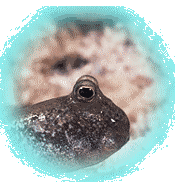Mudskippers: Walking Fish
https://www.vexen.co.uk/holyshit/mudskipper.html
By Vexen Crabtree 2000
 Mudskippers are quite literally walking fish and the imagery they give us is a good indication of the evolutionary steps that brought us out of the oceans. They rand in size from 4 to 12 inches long. There are various different species of mudskipper but they are all similar. The eyes move independently and can see in all directions either on land or in the water.
Mudskippers are quite literally walking fish and the imagery they give us is a good indication of the evolutionary steps that brought us out of the oceans. They rand in size from 4 to 12 inches long. There are various different species of mudskipper but they are all similar. The eyes move independently and can see in all directions either on land or in the water.
Unlike most fish, mudskippers spend much of their life out of water. How do they do it? Mudskippers are fish and so they have gills. Once out of the water, their gills begin to dry out and stick together, so mudskippers have a special cavity behind their ears where sea water is stored. As they rotate their eyes, pressure is applied to that cavity and this reoxygenates the stored water, lubricates the gill flaps and restores the gills to their normal function.
Scientific Name:
Periophthalmus barbarus or Periopthalmus koelreuteri. Mudskippers belong to the largest family of marine fish, the Gobiidae.
 The eyes have it
The eyes have it
Mudskipper eyes are remarkable! These amphibian-like fish have large eyes mounted on top of their heads. This allows for a fantastic panoramic view. The eyes are protected by a clear layer of skin. Since they have no tear ducts to keep their eyes moist, they alternately roll their eyes backwards into their sockets!
 A fish that walks?
A fish that walks?
Mudskippers have highly modified large pectoral (front) fins which are used like legs. Instead of swimming like most fish, mudskippers use their pectoral fins to walk on land and under the water.
Habitat:
(Indo-pacific, West Africa, Japanese coasts, Australia, Philippines and the Polynesian islands). They inhabit both land and underwater areas. They remain on swampy land, lagoons, and river estuaries. They spend three quarters of its time on land, returning to the water to take water into its storage gills. They perch on mangrove roots and root-branches.
Diet:
Insects, sandworms, small crustaceans (all found in mangrove swamps). They will eat other small creatures if provided with them (such as crickets, their staple food in zoos).
Walking:
They walk and hop around in muddy environments and on roots. Their two large pectoral articulated fins are shaped like small legs. Their two dorsal fins are developed and ideal for wiggling on the land and for moving inside river sludge. Their tail also provides some motionary force.
Eyes:
They can retract their eyes into their eye sockets, rolling them backwards to moisten them - the same action lubricates their gill flaps and allows them to breathe.
Breathing:
A species of mudskipper, Periophthalmus vulgaris, has particularly evolved versions of the mudskipper's breathing apparatus: Breathing sacs bounded in a highly folded thin layer of cells. This epithelium is flush with blood vessels. This is a simple version of mammalian lungs. They absorb oxygen from these chambers into their blood. They use their gills to breathe air - but keep their gills wet by wiping them with their fins.